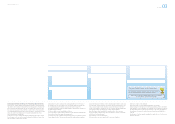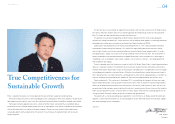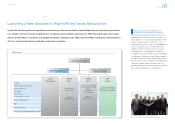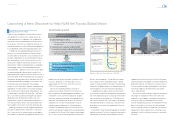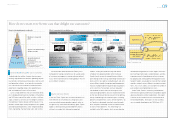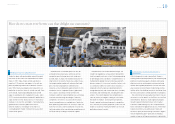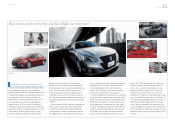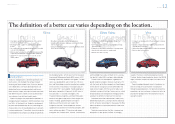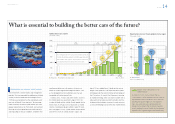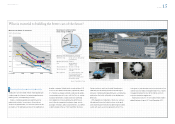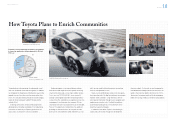Toyota 2013 Annual Report Download - page 12
Download and view the complete annual report
Please find page 12 of the 2013 Toyota annual report below. You can navigate through the pages in the report by either clicking on the pages listed below, or by using the keyword search tool below to find specific information within the annual report.
Toyota Global Vision President’s Message Launching a New Structure Special Feature Review of Operations
Consolidated Performance
Highlights
Management and
Corporate Information Investor InformationFinancial Section
Page 12
NextPrev
ContentsSearchPrint
ANNUAL REPORT 2013
Accelerating the development of compact cars in
emerging markets
Toyota has reorganized its automotive operations into
four business units to propel the company toward
achieving the Toyota Global Vision. The Lexus brand is
now independent, and Toyota brand operations are
divided into those in emerging markets and those in
North America, Europe, and Japan to refl ect their mark-
edly different business models and to accelerate deci-
sion making in tune with local market needs.
Toyota has progressively expanded its operations in
emerging markets (especially in ASEAN countries) since
the 1960s. In Southeast Asia, Toyota has endeavored
for years to build relationships of trust, weathering the
Asian currency crisis to steadily deliver cars that match
customer preferences. These efforts have culminated in
the development of compact cars designed specifi cally
for emerging markets, with the launch of the Innovative
International Multipurpose Vehicle (IMV) series in 2004
heralding a particularly important turning point. The IMV
series was developed for sale in more than 140 coun-
tries, and Toyota began manufacturing fi ve base models
in fi ve countries simultaneously. A local parts procure-
ment ratio of 100% was targeted, thereby keeping car
body prices competitive. At present, the IMV series is
manufactured in 12 countries and regions, with
Thailand, Indonesia, Argentina, and South Africa posi-
tioned as four global supply bases. Diesel engines are
made in Thailand, gasoline engines are made in
Indonesia, and transmissions are made in the
Philippines and India. These components are then
supplied to the countries that make the car bodies. IMV
series vehicles are sold in 170 countries and regions
throughout Asia, Europe, Africa, Oceania, Latin America,
markets. The Vios is currently produced and sold in
Thailand, Toyota’s largest production base in the ASEAN
region, and there are plans to export it to more than 80
countries.
Toyota’s guiding philosophy since its foundation has
been to contribute to communities the world over
through localized operations. Our desire to exceed the
expectations of each and every customer has led us to
promote the development of the automotive industry
around the world.
and the Middle East, and as of March 2012 a cumula-
tive total of 5 million IMVs have been sold worldwide.
The IMV series was developed as a globally inte-
grated model for all regions; however, starting in 2010
with the launch of the Etios compact car, Toyota began
to manufacture a range of cars that better refl ect the
needs of each region. With the launch of sedan and
hatchback versions of the Etios, Toyota now has a total
of eight compact cars designed for emerging markets
and plans to sell them in more than 100 countries.
Production of the Etios commenced in India (2010),
followed by Brazil (2012), and most recently Indonesia
(2013), at Toyota’s second plant in Karawang. The Etios
Valco hatchback has quickly become the “national car
of Indonesia.”
Toyota also manufactures the Vios, a compact car
designed as a step up from the Etios, in emerging
• Steel plates protecting the underbody of the car from
loose rocks on rough roads
• Beverage holder capable of carrying seven one-liter
bottles
• Air conditioner vents arranged side-by-side to circulate
cool air to the rear seats
• Best-in-class fuel economy with 17.6 kilometers per liter
of gasoline (calculated according to Indian standards)
• Optimizations based on 101 factors specifi c to the
Indian market
• Bioethanol-compatible fl ex fuel specifi cations
• Stability while driving on highways, and a comfortable
ride on rough roads
• Dust proofi ng specifi cally for customers in Brazil, where
dust can be a problem
• A cut above the rest, with an elegant design that
evokes status
• One-touch power windows and other extras in high
demand locally
• Extremely roomy interior and plenty of storage space
• Smooth ride and comfort on rough roads
• Best-in-class fuel economy
• Compact car developed from the ground up for emerg-
ing markets
• Dynamic, elegant and clean exterior; pleasant interior
offering value for money
• Optional package offering superior comfort in rear seats
• Best-in-class fuel economy
India
Etios Etios Valco Vios
Brazil Indonesia Thailand
The defi nition of a better car varies depending on the location.
Making Ever-Better Cars [6 of 10] Enriching Lives of Communities Stable Base of Business
(
g
izations based on 101 fac rs specifi c to th
s based on 101 fac
to
o
to
to
rs specifi c to t
h
on 101 fa
m
a
r
ke
e
t



